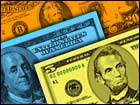
NEW YORK (CNN/Money) - Imagine opening your wallet and seeing a rainbow of dollar bills: a pale yellow $20, a baby blue $50, or maybe even a lavender Benjamin.
The idea isn't that farfetched. The U.S. Treasury Department recently testified before Congress about the need to change U.S. currency to keep ahead of growing counterfeit operations. And one security feature that may be added to the bills is what the U.S. Bureau of Engraving and Printing (BEP) terms "a subtle background color".
So is that it for the greenback? Ink used to print on the front of the bills would still be black, and ink on the back would stay green. But, said Jim Hagedorn, a spokesperson for the BEP, "each redesigned denomination would have a different background color. It wouldn't look its traditional green."
The changes could take effect as soon as 2003, said Hagedorn.
Monopoly money?
The addition of background color and other security features would make it harder to counterfeit bills, said Hagedorn, a problem that has grown in recent years, with the advent of inkjet printers and modern photographic technology. (Commonly faked bills are usually in large denominations -- as a result, the Treasury Department has no plans to redesign the $1 bill).

Of the 47.5 million counterfeit bills circulated in the U.S. last year, 39 percent are what the U.S. Secret Service calls "P-notes", or computer and inkjet-printed notes, as compared to 1995, when less than 1 percent of counterfeit notes came from a computer.
"Before this technology emerged, you had to be a skilled printer to make counterfeit bills," said Jim Mackin, a spokesperson for the U.S. Secret Service. "Now, it's easier."
Color and additional changes are the latest attempts by the Treasury to thwart counterfeiting. Bills were changed in 1996 to include larger, off-center portraits of the presidents and a watermark visible when bills are held up to the light. Those bills were known as the "NCD" (New Currency Design) notes; the newer bills are known as the "NexGen" (Next Generation) notes.
"The 1996 changes were very successful in allowing the public to be the first line of defense against counterfeiting," said Mackin. "That allowed anyone standing in line at the grocery store to determine whether they had a real bill in their hands. We want to encourage people to take a second and authenticate their money."
Would changing the color of money make us all able to sniff out fakes? That remains to be seen. But while the Treasury Department has remained tight-lipped on exactly when the NexGen bills will hit the streets, they seem to be moving ahead on the issue.
"The Treasury, the Fed, and the Bureau of Engraving and Printing are all preparing for changes," Hagedorn said. "We're getting to the point where the currency will have to be redesigned."

|

